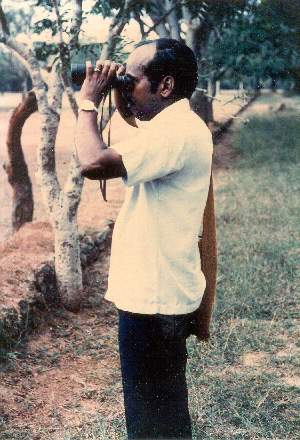
Home | Biodata | Biography | Photo Gallery | Publications | Tributes
Nature Study

 |
Home | Biodata | Biography | Photo Gallery | Publications | Tributes Nature Study |
 |
Birds have been recorded at Tambaram (80° 7' E. 12o 55' N.) since I938 (J. Bombay Nat. Hist. Soc. 40:467-76; 744-7 and 56:637), and I wish to add here some more species that have so far not been recorded from this area. The 300 acre campus of the Madras Christian College is made up of scrub jungle, open fields, marshy areas and flowering trees. Around the campus there are several tanks which dry up during the hot weather. The observations given here are confined to an area of three-mile radius, and those made from 1960.
The Honey buzzard (Pernis ptilorhynchus) is met with singly in the scrub jungle from November to April. It is usually mobbed by the common crows and chased from tree to tree. The Peregrine (Falcon peregrinus) was once seen in the scrub jungle in December 1960. The Red Winged Crested Cuckoo (Clamator coromandus) was seen by Mrs. Siromoney and me on Oct. 25, 1962. It stopped for a few minutes in the garden in the Argyreia Campanulata bushes. The Indian Plaintive Cuckoo (Cacomantis merulinus) is a visitor every year and is a winter resident from November to April.
The Grey-headed Mynas (Sturnia malabarica malabarica) was seen on Feb.l967, and again in the same month this year in the company of Black headed Mynas, eating the berries from the Zizyphus Oenoplia bushes. In Feb.1962, there were more berries than the birds could manage and a single Rosy Pastor (S.roseus) was seen on Feb.14, 1962 in the company of the mynas.
The female Red-breasted Flycatcher (Muscicapa parva) was noted every year between November and March. The male was seen for the first time on Mar.10, this year and it turned out to be the European variety as it had no black borders on the breast. The bird usually confines itself to a small area and the call consists of 'chip, chip, chip' made in its flight.
The Southern Orange-headed Ground Thrush (Zootherea citrina) is much less common than the northern variety. In January, 1962, a single bird came to our bird-bath regularly and was seen by my wife and me.
A group of Yellow Wagtails (Motacilla citreola) was seen in a local tank between March 20, 1961 and April 25, 1961 almost every birds groups varying from 3 to 20. The Forest Wagtail which we have already recorded, is known to stop at Tambaram during its southern and return movements every year.
The Rufous-breasted Mannikin (Uroloncha rufiventris) was seen once in the jungle on Nov.3, 1961 and again after 3 days. It was making incessant noise and its mate could not be seen but was heard. The Spotted Munia (U. punctulata) is seen occasionally in pairs. The number of species of birds recorded in Tambaram is 96 but the list does not contain some of the common birds which I have observed. They are the Cattle, the Little, and the Large Egrets, the Common Bustard Quail, the White-breasted Water-hen, Wood Sand-piper, the Fantail Snipe, the Little Stint, the Indian Courser, the Whiskered, Gull-billed and the Caspian Terns, the Swallow, Blyth's Reed Warbler, and the Full Green Leaf Warbler.